
The term “express”, according to British gun maker W.W. Greener in his 1881 book “The Gun and its Development”, originated with muzzle loaders, muzzle loaders that held a large powder charge and pushed a light weight projectile to long ranges. Originally referred to in 1855 as a Cape rifles, named after the South African plains region, Greener senior produced 40 and 52 caliber rifles that were sighted to 1,200 yards and beyond.
In 1856, Purdey built two similar rifles for members of British nobility and named that model firearm “Express Train”, which led to “Express Rifle” becoming the standard connotation for flat shooting, long range rifles. By 1868, the British government had identified the Express Rifle as a Seventh Class of firearm that required government Definitive Proof certification as a rifle intended to be fired with a larger than ordinary charge of powder.
The Winchester Model 70 Safari Express
The 375 H&H chamber was available with the initial introduction of the Winchester Model 70 in 1936 and has been included in Winchester’s line up ever since. The 375 H&H was chambered in the standard Winchester Model 70, sometimes in the more specialized models wearing names like Safari Express, the African or the Custom African Safari. The 1956 African launched the then new 458 Winchester Magnum. There have been many variations of these models chambered for the: 375 H&H Mag, 416 Rem, 458 Win Mag, 470 Capstick, 458 Lott, 375 Rem UM, 416 Rigby, 404 Jeffery, and 338 Win Mag. No doubt the largest selections follows the cyclical nature of America’s infatuation with powerful firearms.
|
Winchester Model 70 Safari Express |
|
| Manufacturer | Browning Viana |
| Point of Origin | Portugal |
| UPC | 048702002519 |
| Caliber | 416 Remington Magnum |
| Magazine Capacity | 3 |
| Barrel Length | 24 |
| Twist Rate | 1:14″ |
| Trigger | Winchester M.O.A. Stainless |
| Trigger Pull | 3 lbs 10 oz |
| Barreled Action | Alloy Steel – Matte |
| Bottom Metal | Allow Steel – Matte |
| Metallic Sights | Adjustable Rear – Ramped Bead Front |
| Scope | Drilled & Tapped |
| Safety | 3 Position Wing |
| Rifle Weight Empty | 9 lbs 0 oz |
| Overall Length | 44 3/4″ |
| Stock | Grade 1 Black Walnut Satin |
| Checkering | Cut 20 LPI |
| Length of Pull | 13 3/4″ |
| Drop at comb | 1/2″ |
| Drop at heel | 1/2″ |
| Recoil Pad | Pachmayr Decelerator |
| MSRP | 1,499.99 |
The latest version of the Winchester Safari Express was reintroduced in January of 2010. It is available in three cartridges: .375 H&H, 416 Remington and 458 Winchester magnums. Anyone of them has more than enough power to convincingly drop the largest animals on the planet with selection driven by personal preference and regulatory constraints.
The Safari Express is an alloy steel hardware firearm, including its substantial bottom metal. Relatively slender stock lines, the Winchester still has a 3+1 round capacity and hinged floorplate to facilitate easy loading and unloading. Why all of the steel where aluminum often appears? The steel adds to the rifle’s rigidity and most folks prefer a little more recoil dampening heft when it comes to a 416 Rem Mag. A 7 pound sporter, loaded with a 400 grain bullet generates 93 ft-lbs of recoil, while the 9 lb Safari Express reduces kick to a scant 72 ft-lbs.
The swept pistol grip and longish pull, combined with a very straight 1/2″ drop at comb and heel represents good stock geometry for a rifle with hefty recoil.
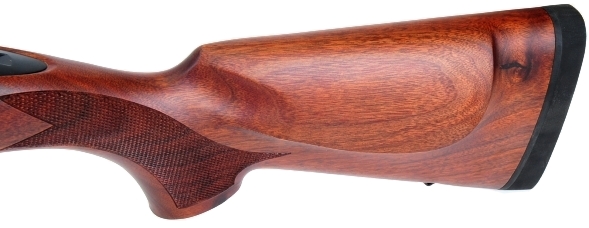
No Monte Carlo comb to beat the shooter about the head and ears, the soft cheek piece lends good metallic or scoped shooting support, but moves away from a shooter’s face under recoil. I’ve tried many recoil pads, but the Decelerator mounted on the Safari Express is the most effective in reducing felt recoil and the most compact.
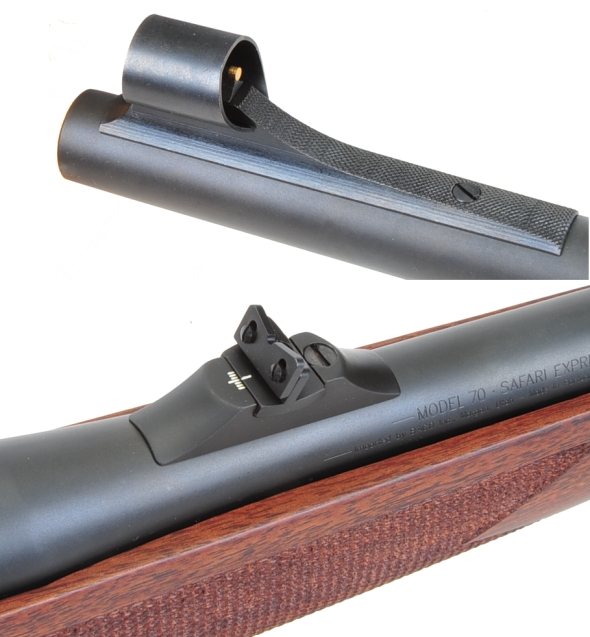
The sight set is appropriate for this type of rifle; simple; durable and sufficiently adjustable. The notched rear sight is adjustable for windage and elevation and indexed to recall settings. The front sight is a stippled ramp type with a dovetail mounted gold bead that offers a very clean, non glare sight picture. Everything stays put even under 416 Rem Mag recoil. The cartridge is actually quite flat shooting, so the drilled and tapped scope mount locations are useful.
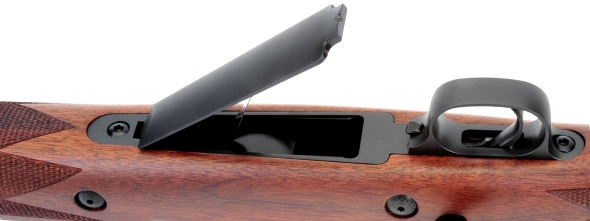
At a time when multipart poly and aluminum bottom metal pieces have made their way on to even pricy firearms, the Winchester Safari Express rifle has maintained a quality, one piece guard and floorplate frame, as well as a hinged steel floorplate. Only the follower is aluminum, a good material for the complex-compound curves that aid in smooth feeding. The floorplate release is in front of the trigger guard, away from hands and fingers that might inadvertently pop open the floorplate.
As a result of having to feed and cycle 3.600″ long cartridges, the Winchester Model 70 Safari Express is built on the Winchester long action. The bolt is a twin lug with 90º lift. It has a full length, controlled feed extractor and a gas block behind the left lug. The shape of the bolt knob is comfortable in use, the knurling makes for a useful non-slip surface and the jeweled bolt body is a nice touch.
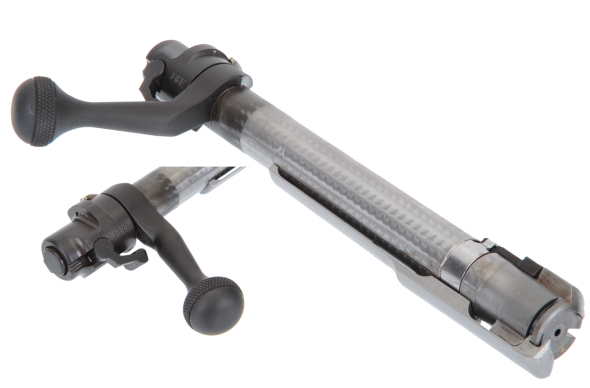
The three position swing safety is positive in operation and quiet. The positions are fire, safe with bolt free to cycle and safe with bolt locked in battery.
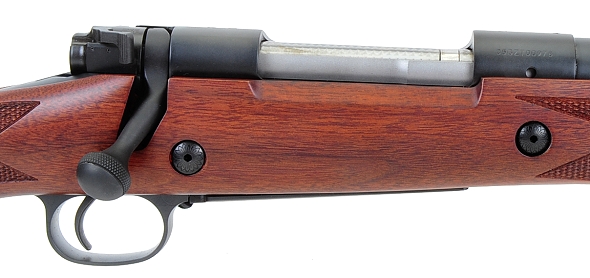
The Safari Express features glass bedded, dual recoil lugs, forward and aft action. The barrel is full floating. The fancy little cross bolts are both decorative and functional. The Winchester Model 70 Safari Express is plain in execution, well made and a quite beautiful firearm.
The 416 Remington cartridge and some of its peers
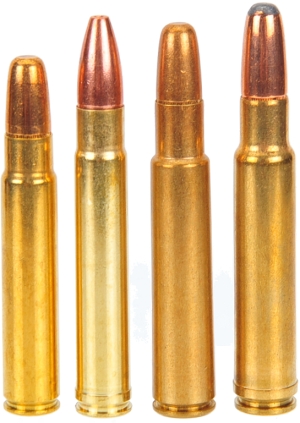 For an average deer hunter, a 0.416″ bullet cartridge might seem niche and lacking in flexibility, but this caliber are quite popular with big game hunters and new cartridge designs are released about once each generation. From left to right: 416 Ruger 2009, 416 Remington 1988, 416 Rigby 1911, 416 Weatherby 1989, Each having its own back story.
For an average deer hunter, a 0.416″ bullet cartridge might seem niche and lacking in flexibility, but this caliber are quite popular with big game hunters and new cartridge designs are released about once each generation. From left to right: 416 Ruger 2009, 416 Remington 1988, 416 Rigby 1911, 416 Weatherby 1989, Each having its own back story.
Folks like to point to the 416 Hoffman of the late 70’s as the origins of the 416 Remington Magnum, and there are several print magazine authors who take personal credit. I’d think the 416 Barnes Supreme, a well established cartridge of the 1950’s would be more of an association. The Barnes Supreme is a full length 375 H&H case, opened up and blown out to accommodate a 0.416″ bullet and to increase case capacity. Remington’s approach was to neck up their existing 8mm Remington magnum and concluded with a case with greater taper than the Hoffman or Barnes Supreme and with approx 4 grains less capacity.
Performance difference is negligible between the versions. The Remington cartridge can be fired in either of the other two, which would result in fire formed brass, but not vice-versa. The compact and high pressure 416 Remington duplicates the 400 grain bullet at 2,400 fps performance of the significantly larger 416 Rigby. The Remington Mag version can be chambered in any action long enough for the 375 H&H Magnum, while the 416 Rigby needs an overall larger action to handle the Rigby’s larger than life diameter.
| Cartridge | Case head Diameter |
Case Length |
Overall Length |
Case Capacity Grains |
MAP PSI |
400 Grain Factory FPS |
Kinetic Energy Ft-Lbs |
| 416 Ruger | 0.532 | 2.580 | 3.340 | 104 | 62000 | 2400 | 5115 |
| 416 Remington Magnum | 0.532 | 2.850 | 3.600 | 107 | 62336 | 2400 | 5115 |
| 416 Rigby | 0.589 | 2.900 | 3.750 | 128 | 47137 | 2400 | 5115 |
| 416 Weatherby | 0.604 | 2.913 | 3.750 | 140 | 63817 | 2700 | 6474 |
There are a few comments I can add to what appears on the table. Both Ruger and Rigby cases are beltless and net larger in diameter than H&H belted based cases. The Ruger will work in a 30-06 length action and it can duplicate Rigby ballistics generated with a 24″ barrel from a 20″ barrel. The upside is a 416 Mag that weighs 7 lbs or less. The downside is a 416 Mag that weighs 7 lbs or less. Both the 416 Rigby and 416 Weatherby require oversize magnum action to accommodate their large physical sizes. The Rigby, the antique in the group, yields little other than 400 grain bullets at 2400 fps with a relatively low pressure cartridge. The 416 Remington Magnum is the most balanced within this group and it is well suited to the form and intent of the Winchester Safari Express.

If the 416 Remington Magnum (far right) looks familiar, it is probably because it is the offspring of the full length 375 H&H Magnum (near right), a cartridge that has spawned more successful, and no so successful, commercial cartridges than any other. In shortened form it was the basis for the 264 Win Mag, 300 Win Mag, and 458 Win Mag. Over at Remington it was the 7mm Remington Magnum and at Weatherby it was the 257 WM, 270 WM, and 7mm WM. In long form it became the 8mm Rem Mag, the 300 and 340 and 375 Weatherby Mags, the subject 416 Remington Mag, and the 458 Lott. Yes, there are even more derivative rounds.
For a Safari Rifle, the 416 Remington makes a lot of sense as there are parts of African where the 375 H&H has been regulated out of use for the largest game and the greater penetrating 416 Remington offers a tangible advantage over the 375 H&H. Subsequently, the Safari Express is offered in 375 H&H, 416 Remington and in the traditional, heavy hitting 458 Winchester Magnum. There are six companies providing ammunition for the 416 Remington, a combined twelve different loads, with bullet weights of 400 and 450 grains. Price runs from $80 to $120 for high grade factory ammo in boxes of 20 rounds. Nosler, for no obvious reason, charges $180 as the others also feature excellent bullet selections and ballistic performance.
As a guy who doesn’t like to represent the 401k matching for ammunition company executives, I tend to handload. Let’s see what that looks like… At discount retail, Hornady brass is priced at $1.18/round and Norma, the only other company making 416 Rem Mag brass is priced at $2.80/round. Both are readily available. 0.416″ bullets are actually pretty inexpensive with even premium brands running between 80 cents and $1.40 per, both soft nose and solids. Yes, there are some screw machine produced bullets that go as high as $4 per bullet, but they are silly in design and offer no value for the hunter. Back to the point… cost per 20 handloads runs roughly $55 to $65 to assemble very good 416 Remington Magnum ammo.
Now that it is nap time for me…
This is one of those projects I enjoy. Excellent modern classic of a rifle, a cartridge that goes thump and a load of components to assemble into handloads. I will be back with some live fire exterior ballistic and accuracy data.
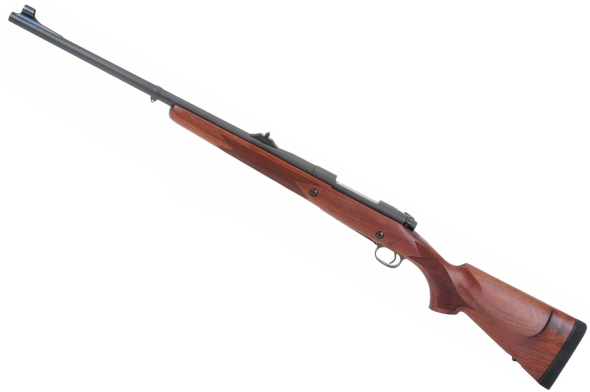
Winchester’s Model 70 Safari Express – 416 Rem Mag Part 1
Winchester’s Model 70 Safari Express – 416 Rem Mag Part 2

Email Notification